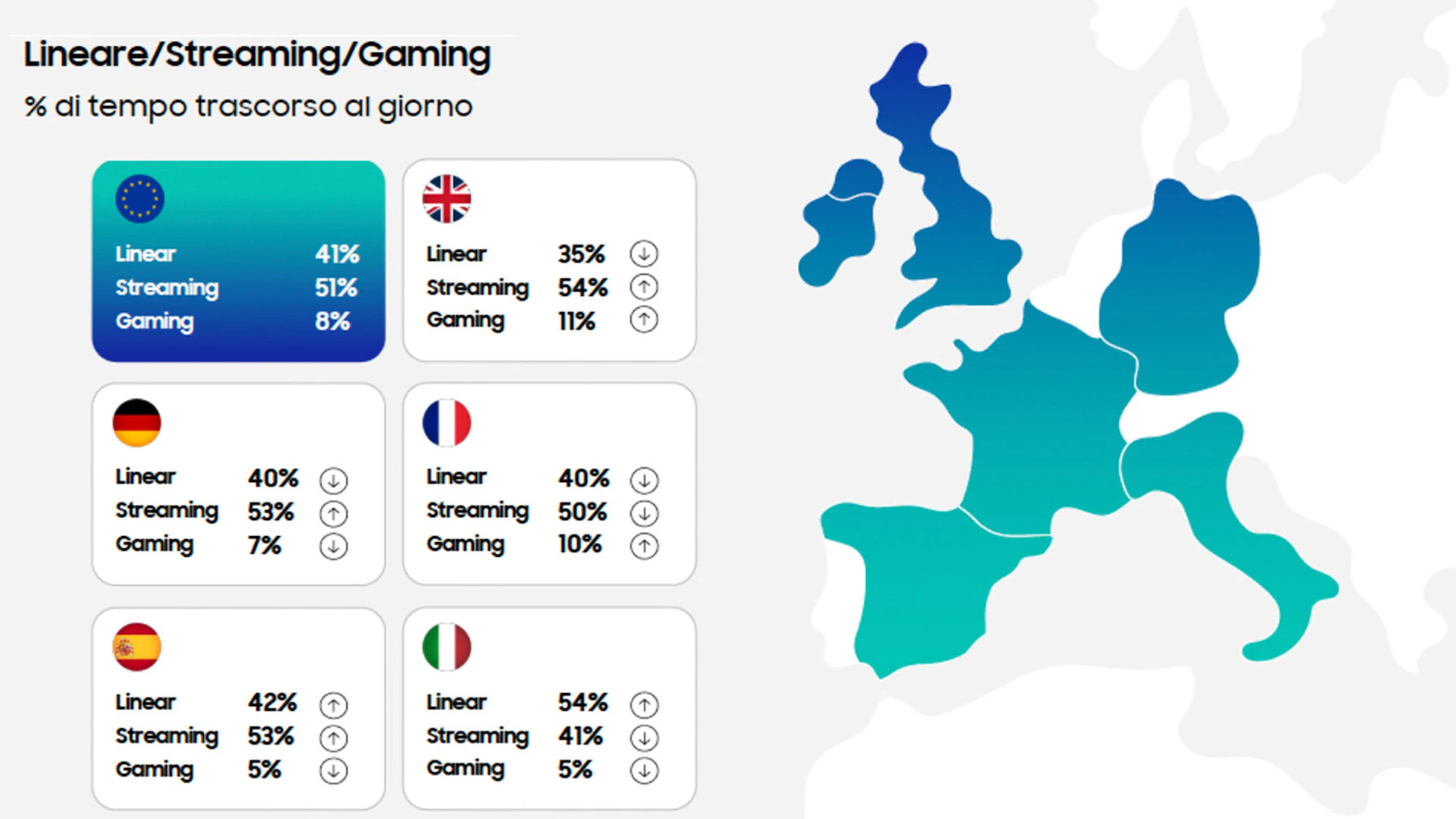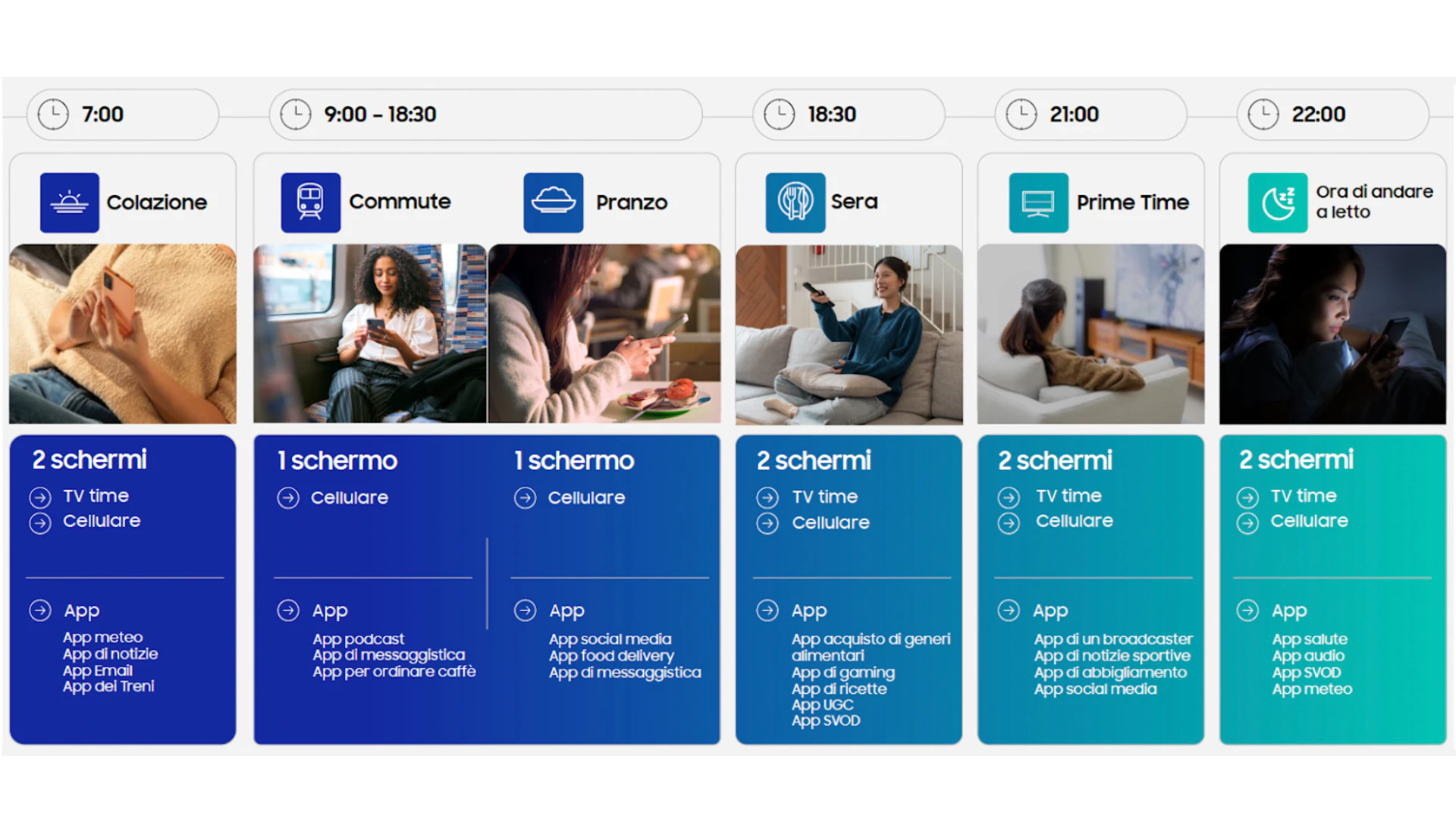Negli ultimi anni, il ruolo del media planner sta cambiando in modo profondo e, per certi versi, radicale. Non basta più presidiare i canali: vanno compresi, al fine di anticipare i comportamenti che li attraversano.
Il consumo di contenuti è diventato fluido, frammentato e trasversale. La TV lineare convive con lo streaming, il gaming e le app, all’interno di un ecosistema in cui i confini tra intrattenimento, informazione e interazione si fanno sempre più sfumati. Pianificare non significa più colpire un’audience predefinita, ma intercettare comportamenti, contesti e intenzioni.
In questo senso, il report TV Phone Home di Samsung Ads è prezioso non tanto per i numeri in sé, quanto per l’approccio che promuove: una lettura cross-device e cross-comportamento, capace di restituire la complessità delle nostre abitudini quotidiane.
Il documento identifica tre ambienti chiave di fruizione, mettendo in luce un cambiamento di prospettiva decisivo: la TV non è più un semplice canale. È un hub di contenuti all’interno di un ecosistema sempre più convergente: dallo streaming al gaming, dalla visione passiva all’interazione attiva. Ogni accesso al device è potenzialmente un portale verso l’intrattenimento. E in questo scenario, ogni “momento d’uso” diventa un’occasione di comunicazione.
La velocità con cui questi comportamenti evolvono varia sensibilmente da Paese a Paese, evidenziando in Europa una frammentazione non solo demografica, ma anche culturale e comportamentale.
I dati confermano differenze profonde tra mercati europei:

La TV lineare resta un touchpoint rilevante: il 41% della popolazione europea la segue regolarmente. Tuttavia, l’ascesa dello streaming sta ridefinendo in modo profondo le abitudini di consumo, frammentando l’audience e moltiplicando i contesti di fruizione.
In questo scenario, l’Italia si distingue per un legame ancora forte con la TV lineare, con un tasso di fruizione che raggiunge il 54%. Si tratta di una specificità culturale che non frena, ma anzi accompagna una trasformazione profonda del panorama media, sempre più orientato verso modelli digitali e ibridi.
Lo conferma anche la dashboard UPA in collaborazione con Nielsen: gli investimenti pubblicitari si stanno progressivamente spostando verso il digitale, segno di un adattamento strategico all’evoluzione dei comportamenti di visione.
Gli investimenti digitali (in verde) sono in costante crescita, riflettendo l’evoluzione dei comportamenti d’uso generale mentre la TV (in azzurro) mantiene un ruolo centrale e stabile. Al centro invece, con andamento variabile, troviamo gli investimenti destinati ai media tradizionali (periodici, quotidiani e radio).

Questo trend ci conferma la necessità di adottare una logica realmente omnicanale, capace di integrare i punti di forza dei canali tradizionali con la flessibilità, la misurabilità e la personalizzazione offerta dal digitale.
Comprendere e presidiare la complessità decisionale
L’omnicanalità riflette una customer journey sempre più complessa e non lineare, che si attiva fin dal primo stimolo ricevuto e prosegue fino alla decisione finale d’acquisto. A descrivere in modo efficace questa fase intermedia è la teoria ormai ben nota fra i marketer del Messy Middle, che ci aiuta a comprendere i meccanismi comportamentali che influenzano le scelte.
Durante questo percorso, le persone si muovono tra due modalità mentali: l’esplorazione, che le spinge a cercare e confrontare opzioni su più canali, e la valutazione, che porta a restringere progressivamente le alternative fino alla scelta finale.
Tra le due fasi, l’esplorazione è spesso la più delicata. Qui l’utente si muove da un canale all’altro consultando motori di ricerca, social, recensioni, comparatori di prezzo e app alla ricerca di informazioni.
È uno spazio di indecisione, curiosità e confronto continuo, in cui l’utente è esposto a molteplici stimoli e può facilmente distrarsi.
In questo contesto, farsi notare è cruciale: essere presenti nei touchpoint più rilevanti, con messaggi utili, coerenti e ben posizionati.
Nel concreto, questo significa presidiare i momenti critici del processo decisionale con messaggi convincenti, contribuendo ad accorciare lo stesso, offrendo esperienze fluide, omnicanale e coerenti.
Omnicanalità e targetizzazione: verso una pianificazione più fluida e integrata
Sfruttare l’omnicanalità significa andare oltre la frammentazione dei canali, per costruire strategie più precise e personalizzate, in grado di riconoscere lo stesso utente su diversi dispositivi e adattare i messaggi al momento e al mezzo giusto.
Ad esempio, chi ha appena visto uno spot su una Smart TV può ricevere un annuncio correlato o una call to action personalizzata direttamente sul proprio smartphone, anche nei minuti immediatamente successivi.
Insight giornalieri per una pianificazione data-driven
La teoria del Messy Middle ridefinisce il ruolo del media planner, da un approccio meccanico a uno più interpretativo, centrato sulla capacità di trarre insight rilevanti e costruire pianificazioni flessibili e guidate dai dati.

In questo contesto, l’insight che abbiamo trovato più utile e rilevante per il nostro lavoro riguarda proprio l’analisi temporale del comportamento giornaliero dell’utente.
Conoscere il pubblico, e quando o come si connette, è oggi essenziale per massimizzare l’efficacia delle campagne e valorizzare ogni momento strategico della giornata.
Ad esempio, sapere che tra le 21:00 e le 22:00 si registra il picco massimo di utilizzo simultaneo di TV e smartphone cambia profondamente il modo in cui possiamo gestire e ottimizzare gli investimenti pubblicitari. In questa fascia oraria, formati interattivi e contenuti sincronizzati possono generare livelli di engagement nettamente superiori rispetto a campagne standard e non contestualizzate — come l’uso di QR Code in TV, che può incentivare l’interazione e aumentare le conversioni.
Come media planner, dovremmo testare con maggiore sistematicità formati sincronizzati TV-mobile, soprattutto per brand ad alta componente esperienziale.
In sintesi, il futuro della pianificazione pubblicitaria non sarà solo questione di scegliere i canali giusti, ma di costruire esperienze rilevanti e misurabili intorno ai comportamenti reali.
SUNTIMES: cosa ci portiamo a casa
Oggi le persone si muovono tra piattaforme, canali e contenuti in modo frenetico. Non seguono più un percorso d’acquisto lineare, ma vivono esperienze frammentate, fatte di stimoli, confronti e continui cambi di rotta. Ogni interazione lascia un segnale e per i brand, il punto non è essere ovunque, ma capire quando e come farsi trovare. Decodificare quindi i segnali, leggere il contesto e sintonizzarsi sulle intenzioni.
Come si evince dagli investimenti pubblicitari, i brand si concentrano sui canali digital e TV, inteso come device e non più solo come mezzo di broadcasting, e per questo serve un approccio omnicanale, che sappia far interagire la forza dei canali classici con la flessibilità, la misurabilità e la personalizzazione del digitale.
Il futuro della pianificazione non sarà più solo una questione di presenza o di rilevanza, ma dell’equilibrio tra entrambe: capire come si comportano le persone, creare esperienze che abbiano senso e rendere ogni punto di contatto un momento che vale. Significa abbandonare la logica dell’interruzione e abbracciare quella della connessione, dove ogni scelta media è guidata da un’intenzione.
Credits
SUNTIMES
Eleonora Cisini - Junior Media Planner
Gabriele Coviello - Junior Media Planner
Guglielmo Vanasia - Senior Media Planner
FONTI
- Samsung ADS EMEA: Behind the screens - TV Phone Home - Italy Data (Samsungs ADS EMEA)
- UPA - Nielsen: Andamento annuale degli investimenti pubblicitari in Italia dal 1962 (Tableau Public)







